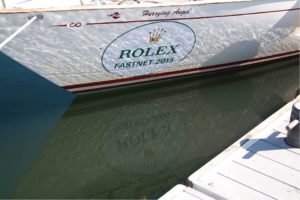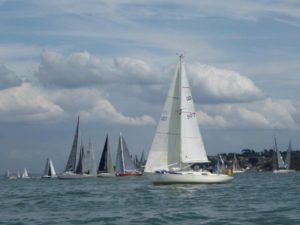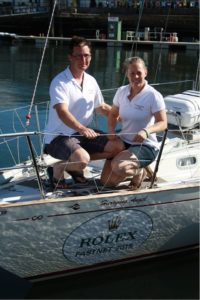On facebook I found this nice story worth sharing it with the comminity and preserving it for myselfe. A report from Lucie Allaway and Tom Barker racing the last years Fastnet 2015 in Lucies Contessa 32 (CO597) „Hurrying Angle“, one of the smallest boats on the course. The Fastnet Race is a long distance race over 650 seamiles, starting in Cowes, going around the Fastnet Rock offshore the Irelandic coast and finishing in Plymouth.
Back in 2014 Lucie and I came up with a crazy idea. “Let’s do the 2015 Fastnet Race double handed, and let’s do it in Hurrying Angel (Lucie’s family Contessa 32) as the slowest handicap boat.” Actually, scrap the word ‘crazy’ and replace itwith ‘mind bogglingly mad’. I had completed 5 Fastnet Races and Lucie 4, with my double handed and solo experience I knew it would it be tough but do-able – and tough it certainly was. And with that, we embarked on our challenge, but just to make it a little bit more challenging we had to plan around the inshore campaign I was running for Ilex which included Cowes Week which finishes 2 days before the Fastnet starts.
Expecting the usual hectic nature of Cowes Week we had tried to anticipate everything that would be needed to be done in order to minimise any pre-race stress and time wasted. To this end, planning started months out with menu options, estimated routings for historic wind forecasts, tidal gate strategies and maintenance / boat work schedules.
But no plan ever goes to quite the way you expect. Just to aid the pre-race stress levels the Royal Ocean Racing Club had asked Lucie and I to partake in their press conference on the Friday morning as we were the slowest handicap boat entered in the race. There we were, sat on a long table next to some of the greats of the sailing world: Ken Reed – Comanche (and North Sails President – effectively my boss…); Morgan Lagraviere- Safran, IMOCA 60 and comedian Gryf Rhys Jones racing his S&S Yawl, as well as other well-known names of the sport – It was a daunting experience but a great one all the same and we wanted to show that we were serious about racing but realistic in our expectations of our final result. With a light wind start forecast followed by stronger breeze later in the week, many were predicting it to be won by a small boat not the big carbon monsters who’d lead us around the race course.
Hurrying Angel (HA) was kept in East Cowes Marina during Cowes Week as mothership to Ilex of Upnor, the X-332 we were racing that week. HA carried a lot of ‘cruising kit’ for this week and at the end of the week all this kit had to be removed and HA went on a weight loss programme to make her the racing snake she is. A large part in helping towards this was aided by Harry and Ann, Lucie’s parents, who brought across all of HA’s racing kit on the Saturday to East Cowes Marina and took away any unwanted kit. Knowing we had this opportunity to prepare her well, we had cooked our food weeks before to be frozen and put on the boat as late as possible in order to keep the cool box cooler for longer; our race kit bags were packed separately from our Cowes Week stuff and sails could be kept in doors and not on deck in case it rained.
In preparing HA to race we had made no alterations to her standard lay out but ensured that all kit carried was essential and needed. Weight was carried as low as possible and confined to the cabin area – there was no weight forward except for her storm sails and just a spare halyard in the cockpit locker. HA has a water tank situated centrally in line with the bilge below the floor boards so carrying 30L of our water supply in there was a sensible idea. Our secondary water supply was carried in the form of 8 x 2L bottles of water stowed near the mast step.
Being double handed meant that even on a relatively cramped Contessa we had enough space to store everything away and therefore could choose food we knew would work well without opting for space saving freeze dried meals. Our food was pre-planned with main meals comprising of fresh frozen food of mince and pasta for the first 3 days, followed by tinned meals and boil in the bag rice for the next 3 days. We carried 2 days’ worth of emergency rations in the form of boil in the bag meals that could be eaten cold should the weather be too severe to cook safely in rough seas. Breakfast was porridge and lunch was sandwiches and pasta. We also had enough snacks, chocolate, biscuits, malt loaf and coffee to feed a crew of 16 for a week. From previous races we have learned that maintaining each other’s morale and energy levels is key and we know that this can easily be achieved by regular re-fuelling and re-hydration.
Race Day
After we’d posed for the traditional pre-race crew photo perched on the bow of the boat, we cast off our lines and went out to the starting area.
H-15 minutes – Boat is ready to go, we are ready to go. One last cup of coffee and a moment of quietness to focus.
H–10 minutes – Jib up and manoeuvring in to our preferred starting area.
H-5 minutes – Start area getting crowded as everyone is looking for clear air – a few cheeky French are still using engines until 30 seconds before the start.
H Hour – Go! And no one is going anywhere very fast as there is no wind… In fact the IMOCA 60s and MOD 70s who started 20-30 minutes before us, were only 100m from the start line!
For the next 3 hours we fought to get any boat speed as the fleet drifted with the west going tide out of the Solent. This was definitely the most sedate yet stressful start to the race I’d experienced. Eventually we could see a ripple of sea breeze starting to set in and the sails set nicely, the boat lent a little and the speed started to build until we were powering out of the Solent at what felt like Mach 1, which in fact was only 4-5kts in 8-10kts of breeze but compared to earlier this amazing.
Now the race had ‘properly started’ we were able to settle into routine and work out how badly the drift had messed with tidal gate calculations and, like the rest of the fleet, what our strategy was now. I managed to download a Grib file (wind, wave, pressure, rain charts) and saw our best option was to head South towards the Casquets TSS and then tack towards Landsend. An option which paid off as we held on to faster boats who couldn’t fully power up in the lighter airs.
Our routine was 2 hours on watch, 2 hours off during the day and ‘1 ON, 1 OFF’ at night so we quickly fell into a pattern of ‘Eat, sleep, sail, repeat’. I have found this watch pattern of short napping works well to maintain energy levels whilst not allowing the person on deck to get over tired and distracted by clock watching.
The first few days were light and shifty. Playing wind shifts was key and anticipating positioning around tidal gates played a large part of our strategy. We had a few shut downs (no wind periods) but luckily the tide was nearly always with us so we could drift in the right direction and rest up. In fact Lucie managed a spot of sun bathing on one particular drift. However, on one shut down we had to kedge near Start Point (drop a light anchor over the side of to hold ground against foul tide). With a water depth of 55m, we found a spare 20m halyard and attached it to the chain and 40m of Kevlar line we usually use. We were lucky and managed to snag a rock or something and stayed still for 4 hours as the tide built, carrying some competition backwards and then started to turn in our favour again. Pulling all this back up was a tough job and after we’d wrangled the kedge back on deck we stumbled toward the cockpit and sat in breathless silence for a minute whilst the boat drifted westwards.
Eventually the wind built, and we were able to make good progress beating to Lands End. As we passed to the south west of the Lands End TSS on Tuesday evening we bore away to a North Westerly course to cross the Irish Sea. One last grib download was possible and we saw that during the night the wind was predicted to build further and visibility was to decrease. This all happened within a few hours of sunset, the wind built to 25 knots from the south-west and very soon we were on our reaching number 3 genoa, ploughing into choppy seas with no visibility and low dark clouds. Unable to see any wave crests from the confused sea in pitch black, the ride was a little uncomfortable to say the least but we powered on with our long keel splitting the waves, over taking a few boats that were struggling with their more modern shallow hull, deep keel designs. During the night, the wind continued to build and we were soon on our Number 4 blade jib – a small yankee cut sail – which had us powering along with 2 reefs in at 6-7 knots. As day broke we had made good progress across the Irish Sea and with day light we could see the waves better and our speeds built to consistent 7 knots all the way to the Rock.
In the low visibility we couldn’t see any other boats, but thanks to AIS we could see there were some other racers around and a few cargo / fishing vessels. Lucie had most of the excitement with other boats, dodging a survey vessel that loomed out of the mist that hadn’t been picked up by AIS, as well as seeing a Nic 55 power past to leeward under full canvas – it was good to know it had taken them that long to pass us but annoying to know they could still carry bigger sails.
That evening we approached the Rock! Lucie was on the helm and I guided us round at the plotter so as not risk getting to close – although she thought I’d taken us too close when there was a loud wave crash on the rocks and the smell of fish – luckily we were just down wind of the spot where the seals like to shelter and the wave crash was a false alarm. A small glass of champagne to celebrate getting to the Rock and then back to business as we still had to get back!
The weather didn’t let up but luckily sailing a reciprocal course meant once we’d cleared the Fastnet TSS we were back on a reaching course, just leaning the other way, heading towards the Scillies and by Thursday evening we were nearly out of the Irish. Overnight the wind eased a bit and we were able to change to a larger genoa to maintain speed and began to watch the GPS ETA which had us arriving in time for the Friday night party (a personal goal of ours).
In the early hours of Friday morning we passed the Scillies and managed to get the kite up and start running towards Plymouth. With a renewed enthusiasm after a tough few days we were determined to get to finish as soon as possible and started rotating through being on deck and power napping to every 5 miles of DTG (Distance To Go) ticked off. This effectively meant we rotated every 45-50minutes during the day time, but as we got closer to Plymouth the wind started to ease and our hopes of getting in for the Friday night party started to falter until eventually at 2200hrs we were 2 miles from the finish in 2 knots of breeze and going very slowly. We had 2 hours to cross the line before the tide running out of Plymouth Hove would be too strong and we would have to kedge in sight of the finish. When we realised this might happen we worked extra hard and used our last reserves of energy to focus and get the boat to the finish. Luckily we caught a breath of wind and were heartedly congratulated by the RORC team sat in the Plymouth Break Water light house who’d been watching our mast head navigation light bob around for the last few hours. We crossed the finish line at 2347 on the Friday.
Before the escort rib could guide us in, there was one last thing to do. I got down on one knee and proposed to Lucie. I had taken the ring all the way round the race hidden away in the med kit box (that would have made an interesting incident had we needed to open it). Of course she said ‘Yes!’, I say ‘of course’ – there was a chance she might have said no, but I assumed that because we’d made it all the round the Fastnet and not thrown each other over board it was a fairly safe bet.
As we started the engine and dropped the sails in a heap on the deck we felt an odd sense of ‘This isn’t right!’ as we could use the engine for propulsion. We followed the escort rib in, sipping on a bottle of champagne but we were worried everyone would have been gone big at the closing party and would be passed out on their boats. But as we passed the shore side crew bar there was a massive cheer and flash of torches as dozens of people welcomed us back in. This was an amazing feeling, we couldn’t stop smiling, and as we came alongside our berth the boat was swamped by friends from other boats. We were totally overwhelmed by the sudden crowd after five days of isolation that we directed the drunken rabble to flake our sails and others shoved glasses of beer, rum and whiskey in our hands and ran below for two final minutes of solitude. After that we were frog marched to the bar and were still there as the sun came up…
In summary, it was a great experience which we both loved. It was an amazing feeling to complete my 6th Fastnet (2nd in a double handed crew) an although at the time you say ‘Never again!’ it only takes a couple of weeks before you start itching for the next challenge and endless horizon.
Results:
Elapsed – 5 days 11 hours 27 minutes
IRC Double Handed – 44 out of 54
IRC Class 4 – 42 out of 71
IRC Overall – 216 out of 309



